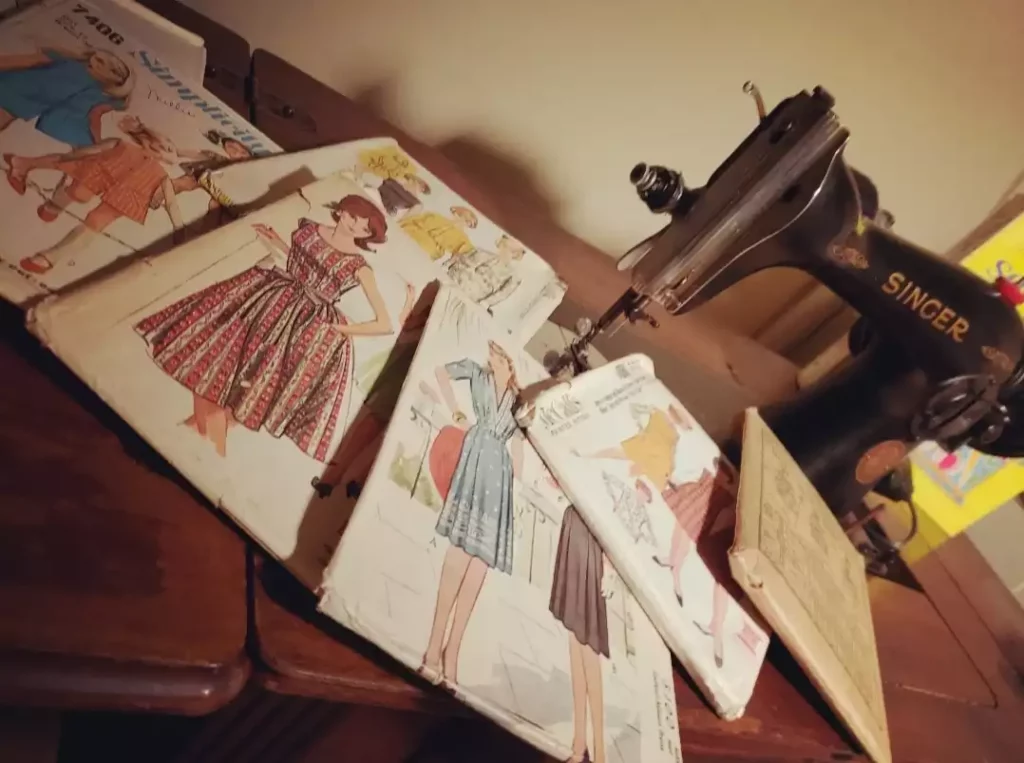
Many of us now have the opportunity to explore new hobbies or get back in touch with old ones. Sewing clothes has been a creative and tactile outlet for me for quite some time. There’s complex thinking and problem solving involved when coaxing one piece into the correct position with another, and then getting everything to fit just right, along with a lot of sewing, ripping out mistakes and resewing. My scarce energy recently has been applied to a related activity: organizing and expanding my collection of vintage sewing patterns.
A sewing pattern is the template a person will use to create a garment or item. Traditionally, they are printed onto tissue paper and come with step-by-step instruction sheets. For a number of years, clothing patterns came with only one size in an envelope, but over time were printed to incorporate multiple sizes. Now you can find patterns online as printable PDFs as well.
While I’ve been collecting vintage patterns for a few years, at the end of March, eBay and I became great friends as I started expanding my collection, driven loosely by my 2020 goal of sewing something from each decade of the 20th century. Not knowing which time periods most of my patterns came from, I decided to inventory and digitally catalog all of my sewing patterns.
Through some research on our library’s databases, I learned that clothing was mostly handmade up until the 1870s, when ready-made clothing came into fashion. In most households, women continued to make clothing for themselves and their family members, which was made easier by the invention of the home sewing machine in 1860. Hours could be saved by sewing with a machine, so even though the cost was high, many families purchased sewing machines with installment plans.
Paper sewing patterns have evolved since their appearance in the 1860s. Butterick was the first to include separate instruction sheets with their patterns. McCall’s started printing seam allowances and grain lines right onto pattern pieces in the 1920s, while some companies didn’t start doing that until decades later. In the 1930s, Hollywood Patterns started making patterns featuring styles inspired by film stars, publishing their photos on the envelopes. In the 1940s, patterns for uniforms and factory workers were developed. Some companies were swapping out illustrations for photos on their envelopes by the 1960s. Over the years, companies came and went, but Butterick, McCall’s, Vogue, and Simplicity are still considered the “big four.”
Many of the pattern companies published magazines to highlight their patterns, especially when they were starting out. A few of these are available to peruse on archive.org, including this issue of Mme. Demorest’s Mirror of Fashions from April 1865; this issue of The Delineator from Butterick in January 1899; and this issue of McCall’s from November 1925.
By now, I have taken pictures of all of my vintage patterns and am working to catalog the specifics of each one on a spreadsheet. The collection is quite varied, but most are from the 1960s. The oldest is a Butterick teen girl’s Bo Peep costume from 1926. While the majority of the patterns are women’s clothes, I have a small selection of children’s and men’s. The best have names or measurements written on them, or long forgotten pins still marking them.
One of my favorite things about this hobby is the shared history. There are generations of women who have experienced sewing first or secondhand, either out of necessity or out of interest. I share my sewing hobby with my mother, who made me clothes for many holidays and special occasions when I was young, and still does sometimes.
If you are interested in exploring sewing or other crafts and have a library card with us, check out Creativebug for curated video tutorials, instructions, and patterns.
Photo courtesy of the author.
